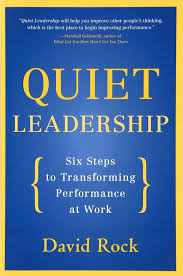“Our leadership practices are not keeping up with the realities of organizational life. The result is an increasing gap between the way employees are being managed at work, and the way they want to be managed.
“Countless surveys have been done in this area, ending in headlines like ‘Six out of 10 workers are miserable’ and ’74 percent of staff not engaged at work’. Dig into these surveys and you’ll see the quality of leadership on top of the list of complaints.”
 Thus begins Quiet Leadership: Six Steps to Transforming Performance at Work, by David Rock. Rock is the founder and CEO of NeuroLeadership Group and the author of several books. In this capacity, he serves as a leadership coach, teacher and public speaker who consults with both business and education. He also manages a Quiet Leader website that can be accessed here.
Thus begins Quiet Leadership: Six Steps to Transforming Performance at Work, by David Rock. Rock is the founder and CEO of NeuroLeadership Group and the author of several books. In this capacity, he serves as a leadership coach, teacher and public speaker who consults with both business and education. He also manages a Quiet Leader website that can be accessed here.
Rock takes a brain-based approach to leadership development and managing others. He believes effective leaders—whether they are positional or informal leaders—help others create new “mental maps” that guide their work and behavior.
He suggests that we often create new mental maps when “we stop speaking and start picturing concepts in (our) own mind.” (p. 5) And, he argues that leaders should help colleagues make their own connections by finding ways to advance the thinking of those they lead rather than trying to do all the thinking for them.
Rock defines quiet leaders as those who empower others unobtrusively. “They stretch people more than people stretch themselves while providing extensive positive feedback. And they know that taking time to establish good processes in any situation is a key to having the most useful conversations.” (p. 71)
Six “quiet leadership” steps
So how do quiet leaders take to empower others in this way? Rock suggests six steps:
1. Think about Thinking
2. Listen for Potential
3. Speak with Intent
4. Dance Toward Insight
5. Create New Thinking
6. Follow Up
Rock summarizes the six steps this way:
► The first step is to think about thinking; to let people do all the thinking, keep them focused on solutions, stretch their thinking, accentuate the positive, and follow good process.
► The second step is to listen for potential, and not to get too close.
► The third step is to speak with intent and to be succinct, specific, and generous.
► Step four is about conversation. We dance toward insight by getting permission for harder conversations, placing people so they know where we’re coming from, using thinking questions so that others do the thinking, and then clarifying their responses.
► Once we know how to dance this way, in step five we create new thinking. We get people to become aware of their mental dilemmas and reflect more deeply on them by asking questions about their current reality. Once they have had an insight, we explore alternatives for how to move their insight into action, then we tap into the energy given off by the new connections being made.
► Finally, (step 6) we know that following up can make a big difference in the emergence of new wiring, so we focus on the facts and people’s feelings. We encourage, listen for learning, look for implications, and then look for the next goal to focus on. (pp. 184-185)
A treasure trove of coaching ideas
Quiet Leadership: Six Steps to Transforming Performance at Work is a treasure trove of ideas and offers many opportunities for reflection on each of the six steps. And, for those of us who manage and/or coach others, it is a valuable resource – one that I know I will turn to often.
For example, Rock reminds us of the challenge of change and offers two actions we can take to help others. First, we should acknowledge to those involved in an organizational or personal change that we understand that change is frustrating. In fact, according to Rock, “our brain is a finely tuned machine dedicated to protecting the status quo, and trying a new way of thinking or behaving can send alarm bells ringing.” (p. 54)
The second action we can take to help others change is to provide ongoing positive and authentic feedback. Rock believes that feedback is so important, he devotes an entire chapter to it.
As I read this book, I made so many connections to other thought leaders, ranging from Edgar Schein on helping others, to Ron Heifetz’s balcony view, which Rock calls the “Clarity of Distance,” to Jackie Walsh’s questioning strategies. In fact, each step is accompanied by a list of powerful questions that quiet leaders can ask to advance another’s thinking.
We, by nature, want to help people. But too often we’re the ones doing the heavy lifting, and then we get frustrated when we don’t see the progress in others that we expect.
This book will help you strengthen your skills at empowering others by encouraging them to do the thinking. When that happens, Rock contends, both parties win.

0 Comments on "How We Can Use Quiet Leadership to Empower Others"